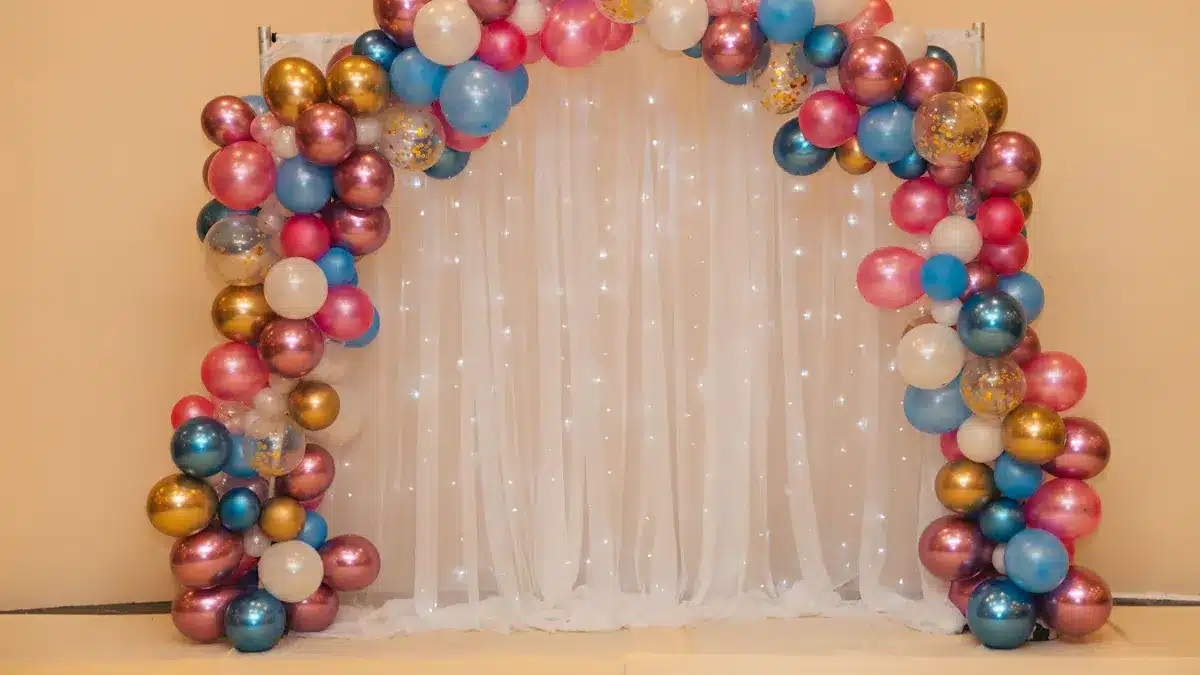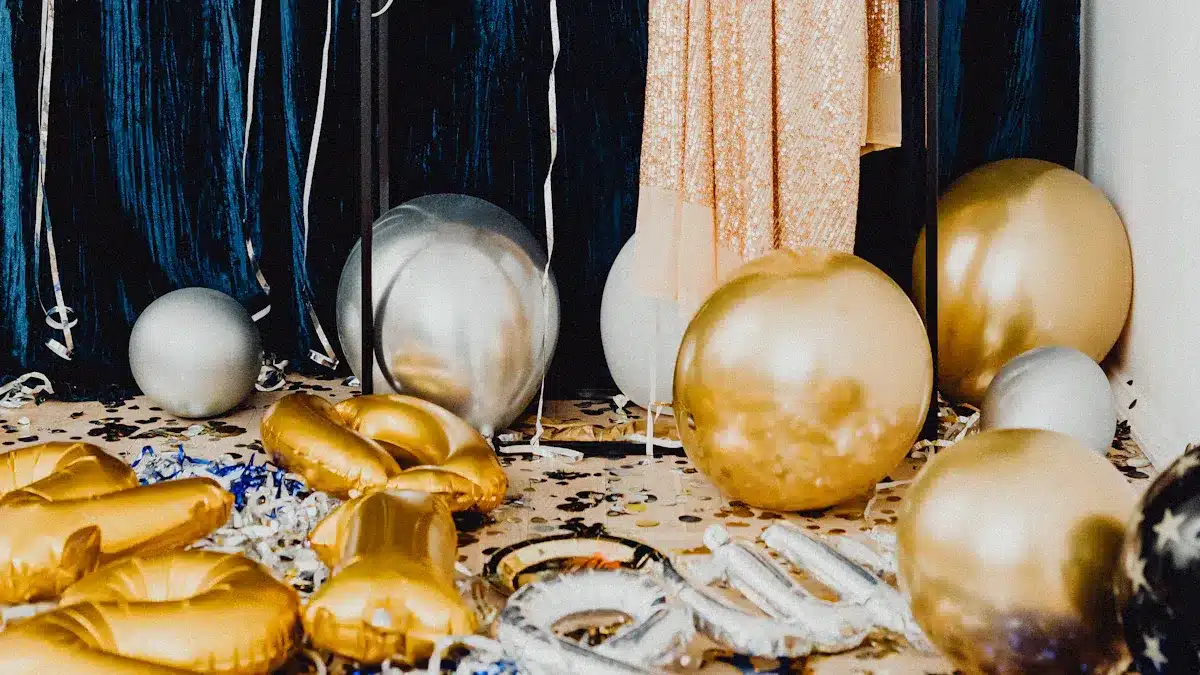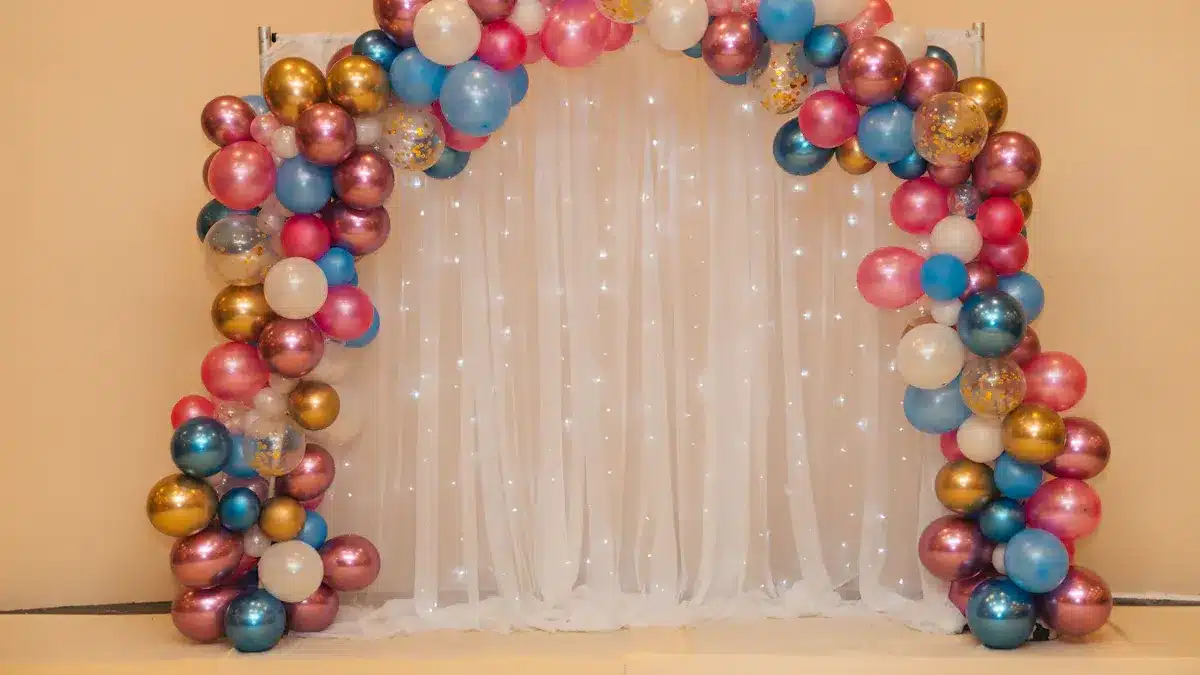
Latex balloons can last anywhere from a few hours to several weeks, depending on how you inflate them and the conditions they face. Helium-filled balloons usually float for 6 to 8 hours, but larger ones treated with Hi-Float can last much longer. Air-filled balloons, on the other hand, can stay intact for days or even weeks. Temperature, humidity, and sunlight also play a big role. For example, high heat stretches the latex, making it fragile, while moisture speeds up its breakdown. By understanding these factors, you can make your balloons last longer and look their best.
Key Takeaways
Balloons with helium float for 7 to 10 hours. Adding Hi-Float can make them float longer, up to 24 hours.
Balloons filled with air last many days or even a week. They are great for decorations that need to last.
Keep balloons in cool, dry spots, away from sun and moisture. This helps them last longer.
How Long Do Latex Balloons Last Based on Inflation Type
How Long Does a Helium Balloon Last
If you’re wondering how long helium-filled latex balloons last, the answer depends on a few factors. Typically, these balloons float for about 7 to 10 hours. However, their lifespan can vary based on the environment and the quality of the balloon. Helium atoms are incredibly small, so they escape through the latex material faster than air. This is why helium balloons deflate more quickly.
Here’s a quick breakdown:
Type of Inflation | Lifespan |
|---|---|
Helium | 7 to 10 hours |
To make your helium balloons last longer, keep them indoors in a cool, dry space. Heat and humidity can speed up deflation. If you’re using Hi-Float, you can extend the float time significantly, sometimes up to 24 hours or more. So, if you’re planning a party, inflate your helium balloons as close to the event as possible to keep them looking fresh.
How Long Do Air-Filled Balloons Last
Air-filled latex balloons last much longer than their helium-filled counterparts. These balloons can stay inflated for several days to a week, depending on the conditions. Unlike helium, air doesn’t escape as quickly through the latex material. This makes air-filled balloons a great choice for decorations that need to last longer.
Type of Inflation | Lifespan |
|---|---|
Air | A few days to a week |
To maximize their lifespan, store your air-filled balloons in a cool, dry place. Avoid direct sunlight and high humidity, as these can weaken the latex and cause the balloons to deflate faster. If you’re asking, “How long will my balloons last?” air-filled ones are your best bet for long-lasting decorations.
Environmental Factors That Impact How Long Balloons Last

Effects of Temperature and Heat
Temperature plays a huge role in how long your latex balloons last. High heat can be especially damaging. When the air inside the balloon heats up, it expands. This stretches the latex, making it more fragile and prone to popping. If you’re hosting an outdoor event on a hot day, you might notice your balloons deflating or bursting faster than expected.
Cold temperatures aren’t much better. In chilly weather, balloons shrink as the latex contracts. This can reduce their float time and make them deflate quicker. Extreme cold can even make the latex brittle, increasing the chances of it tearing. To keep your balloons in good shape, avoid exposing them to extreme temperatures. A cool, shaded area is your best bet.
Impact of UV Exposure and Sunlight
Direct sunlight is another enemy of latex balloons. UV rays break down the latex material, causing it to weaken and lose elasticity. Over time, this leads to deflation or popping. If you’re decorating for an outdoor event, try to place your balloons in shaded areas. You can also use UV-resistant sprays to give them a little extra protection. Remember, even a few hours in the sun can significantly shorten their lifespan.
Role of Humidity and Moisture
Humidity can quietly sabotage your balloons. When latex absorbs moisture from the air, it undergoes structural changes that weaken it. You might notice a chalky or cloudy appearance on the surface of your balloons—this is called oxidation, and it’s a sign that humidity is taking its toll. On humid days, balloons tend to lose their shape much faster.
Moisture exposure doesn’t just affect the balloons you inflate. It can also impact the quality of the latex during manufacturing, making it less durable. To combat this, store your balloons in a dry environment before inflating them. If you’re working in a humid area, consider using a dehumidifier to keep the air dry.
Tips to Extend the Lifespan of Latex Balloons
Using Hi-Float or Balloon Sealants
If you want your helium-filled latex balloons to last longer, using a product like Hi-Float is a game-changer. This ultra hi-float solution creates a protective barrier inside the balloon, slowing down helium leakage. With this method, you can extend the life of your balloons significantly. For example, untreated helium balloons usually float for about 8 hours. But when treated with Hi-Float, they can stay afloat for days! This makes it perfect for events where you need long-lasting decorations.
Here’s why Hi-Float is worth considering:
It can extend the float time of helium-filled balloons up to 25 times longer.
It’s easy to apply and works well with most latex balloons.
If you’re planning a party, using Hi-Float ensures your balloons look fresh throughout the event. However, if you’re using latex balloons without Hi-Float, inflate them as close to the event as possible to preserve their life.
Proper Storage Techniques
Storing your balloons correctly can make a big difference in how long they last. Whether inflated or not, keeping them in the right environment helps preserve the life of latex balloons.
Here are some tips for proper storage:
Store uninflated balloons in airtight, opaque containers to protect them from light.
Keep them in a cool, dry place with good ventilation.
Avoid direct sunlight and extreme temperatures, as these can weaken the latex.
If you’ve already inflated your balloons, cover them with a plastic bag to shield them from dust and moisture.
By following these steps, you’ll ensure your balloons stay in great shape until it’s time to use them.
Choosing Larger or Thicker Balloons
When durability matters, opting for larger or thicker latex balloons is a smart choice. These balloons are more resistant to environmental factors like heat and humidity, which means they last longer. Premium-quality balloons, such as those made with thicker latex, are less likely to pop or deflate quickly.
For outdoor events or situations where balloons need to endure tough conditions, thicker options are your best bet. They not only look great but also help you avoid the hassle of frequent replacements. So, if you’re looking for longevity, go for larger or thicker balloons to extend the life of your balloons.
The life expectancy of latex balloons depends on how you inflate them and the conditions they face. Helium-filled balloons usually float for 8-15 hours, but with Hi-Float, they can float longer than 15 hours. Air-filled balloons last weeks, making them ideal for long-term decorations. Environmental factors like heat, sunlight, and humidity can shorten their lifespan. High temperatures stretch the latex, while cold causes it to shrink. Humidity speeds up degradation, and direct sunlight weakens the material.
To make your balloons last, choose high-quality latex balloons, store them in cool, dry places, and use Hi-Float for helium inflation. By planning ahead and following these tips, you’ll enjoy vibrant, long-lasting decorations for any event.
FAQ
How can I prevent balloons from popping outdoors?
Keep them in shaded areas and avoid overinflating. Heat expands the air inside, making balloons more likely to burst. Use thicker balloons for durability. ☀️🎈
Can I reuse latex balloons after deflation?
No, latex balloons lose elasticity after deflation. Reusing them increases the chance of popping or tearing. Use fresh balloons for the best results.
Why do my balloons look cloudy after a few hours?
Humidity causes oxidation, which creates a chalky or cloudy appearance. Store balloons in a dry place to avoid this. A dehumidifier can help. 💧






